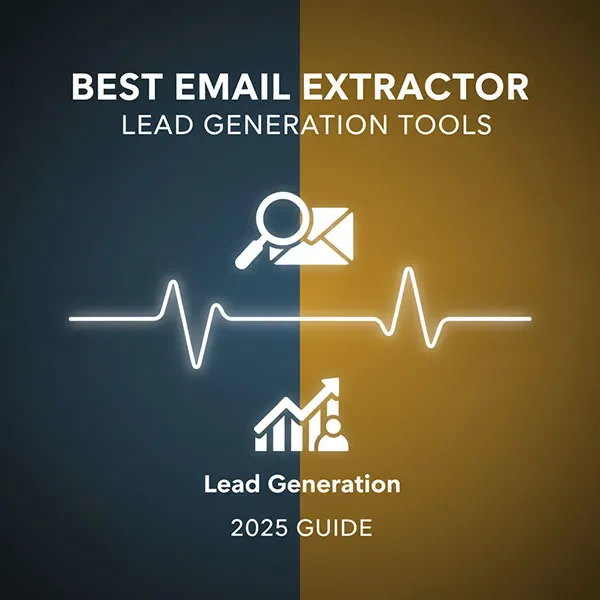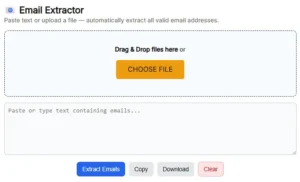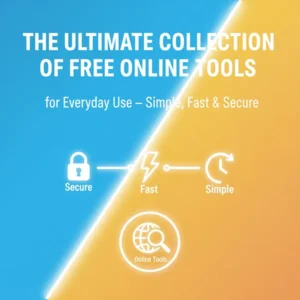Table of Contents

In today’s competitive digital landscape, finding verified business emails is like striking gold for marketers, freelancers, and startups. Whether you’re looking to build a prospect list, conduct outreach, or gather contact information, knowing how to extract emails from a website efficiently and safely is a crucial skill.
Forget endlessly scrolling and copying emails one by one. This guide will show you the easiest and safest ways to find business emails using smart online tools, helping you gather verified leads fast.
Why Extract Emails from Websites?
Before we dive into the “how,” let’s quickly touch on the “why”:
- Lead Generation: Build targeted lists of potential clients or customers.
- Networking: Connect with industry professionals, journalists, or influencers.
- Market Research: Identify key contacts within a specific niche or company.
- Outreach Campaigns: Power your email marketing efforts with relevant contacts.
Remember, always use extracted emails ethically and in compliance with privacy regulations like GDPR and CCPA. Avoid spamming!
The Easiest Way: Using an Online Email Scraper Tool 🛠️
For most users, especially those without coding experience, an online email scraper online is the most straightforward and effective solution. These tools are designed to crawl websites and pull out email addresses automatically.
Step 1: Choose a Reliable Email Extractor Tool
There are many options available, some free, some paid. When choosing, look for features like:
- Accuracy: Does it deliver verified emails?
- Ease of Use: Is the interface intuitive?
- Safety: Does it respect website rules (e.g.,
robots.txt)? - Export Options: Can you export the data easily (CSV, Excel)?
A quick search for “email extractor tool” will give you a list of popular options. Some tools even integrate directly with your browser.
Step 2: Input the Website URL(s)
Most email extractor tool interfaces are quite simple. You’ll typically find a field where you can paste the URL of the website(s) you want to scan.
- Single Website: Paste
https://example.com. - Multiple Websites: Some tools allow you to upload a list of URLs or paste them one per line.
Some advanced tools can even crawl an entire domain, not just a single page, to extract emails from website sub-pages.

Step 3: Start the Extraction Process
Click the “Extract,” “Scrape,” or “Get Emails” button. The tool will then begin its work, scanning the specified pages for email patterns (like name@domain.com).
Here’s an example of what a simple email extractor interface might look like:
Step 4: Review and Export Your Results
Once the extraction is complete, the tool will display the emails it found. You’ll often see:
- A list of email addresses.
- The source URL where each email was found.
- Sometimes, an option to verify the emails to ensure they are active.
Look for an “Export” button (usually for CSV or Excel files) to download your list. This allows you to easily import the contacts into your CRM or email marketing platform.
Other Methods to Find Business Emails
While online tools are highly efficient, here are a few other effective strategies:
1. Manual Search within the Website
Before reaching for a tool, sometimes a good old manual search is all you need:
- Contact Us/About Us Pages: These are primary locations for official email addresses.
- Team/Staff Directories: Larger companies often list individual emails here.
- Footer: Check the website’s footer for general contact emails.
- Privacy Policy: Believe it or not, privacy policies sometimes list a data protection officer’s email.
2. Using Search Engine Operators (Google Dorks)
You can use specific search queries on Google to find emails:
site:example.com "email"site:example.com contactsite:example.com intext:"@example.com"(Replacesexample.comwith the target domain)site:example.com "email us"
These queries help narrow down your search results to pages likely to contain email addresses.
3. Professional Networking Platforms
Platforms like LinkedIn are excellent for finding specific individuals within companies. Once you have a name and company, many email extractor tool browser extensions can guess or find their professional email.
Best Practices for Email Extraction
To ensure you’re using these methods effectively and ethically:
- Respect
robots.txt: Ethical scrapers follow the rules set in a website’srobots.txtfile, which indicates which parts of the site should not be crawled. - Avoid Overloading Servers: Don’t send too many requests too quickly, especially with manual scripting, as this can negatively impact a website’s performance.
- Verify Emails: Always verify extracted emails before sending a campaign. This improves deliverability and protects your sender reputation.
- Comply with Laws: Understand and adhere to email marketing and data privacy laws in your region (e.g., GDPR, CAN-SPAM, CCPA). Always offer an opt-out option.
By following this step-by-step guide and using the right email extractor tool, you can significantly boost your lead generation efforts and find business emails with greater ease and precision. Happy scraping (ethically)!



